《运动解剖学》课程文献资料(脑科学)《非常规教学法:脑科学实用观促进学习》(第三、四章)翻译实践报告
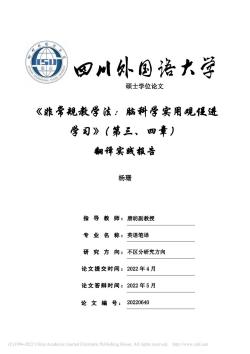
州外图洛大学 硕士学位论文 《张常视教学法:脑科学实用观程进 学习》(第三、四章) 潮泽实践报告 杨珊 指导教师:唐防副教授 专业名称:英语笔译 研究方向:不区分研究方向 论文提交时间:2022年4月 论文答辩时间:2022年5月 论文编号:20220640 (C)1994-2022 China Academie Joumal Electronie Publishing House.All rights reserved.http://www.enki.ne
硕士学位论文 《非常规教学法:脑科学实用观促进 学习》(第三、四章) 翻译实践报告 杨珊 指 导 教 师: 唐昉副教授 专 业 名 称: 英语笔译 研 究 方 向: 不区分研究方向 论文提交时间: 2022 年 4 月 论文答辩时间: 2022 年 5 月 论 文 编 号: 20220640
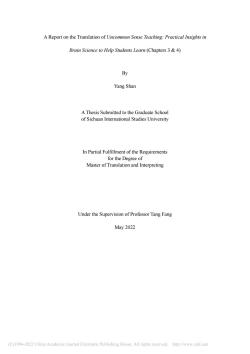
A Report on the Translation of Uncommon Sense Teaching:Practical Insights in Brain Science to Help Students Learn (Chapters3&4) By Yang Shan A Thesis Submitted to the Graduate School of Sichuan International Studies University In Partial Fulfillment of the Requirements for the Degree of Master of Translation and Interpreting Under the Supervision of Professor Tang Fang May 2022 (C)1994-2022 China Academie Joumal Electronie Publishing House.All rights reserved.http://www.enki.net
A Report on the Translation of Uncommon Sense Teaching: Practical Insights in Brain Science to Help Students Learn (Chapters 3 & 4) By Yang Shan A Thesis Submitted to the Graduate School of Sichuan International Studies University In Partial Fulfillment of the Requirements for the Degree of Master of Translation and Interpreting Under the Supervision of Professor Tang Fang May 2022
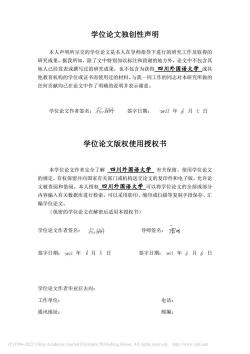
学位论文独创性声明 本人声明所呈交的学位论文是本人在导师指导下进行的研究工作及取得的 研究成果。据我所知,除了文中特别加以标注和致谢的地方外,论文中不包含其 他人已经发表或撰写过的研究成果,也不包含为获得四川外国语大学或其 他教育机构的学位或证书而使用过的材料。与我一同工作的同志对本研究所做的 任何贡献均已在论文中作了明确的说明并表示谢意。 学位论文作者签名:和册签字日期:022年6月5日 学位论文版权使用授权书 本学位论文作者完全了解四川外国语大学有关保留、使用学位论文 的规定,有权保留并向国家有关部门或机构送交论文的复印件和电子版,允许论 文被查阅和借阅。本人授权四川外国语大学可以将学位论文的全部或部分 内容编入有关数据库进行检索,可以采用影印、缩印或扫描等复制手段保存、汇 编学位论文。 (保密的学位论文在解密后适用本授权书) 学位论文作者签名:名册 导师签名:3网 签字日期:202年6月5日 签字日期:2年6月6日 学位论文作者毕业后去向: 工作单位: 电话: 通讯地址: 邮编: (C)1994-2022 China Academie Joumal Electronie Publishing House.All rights reserved.http://www.enki.net
学位论文独创性声明 本人声明所呈交的学位论文是本人在导师指导下进行的研究工作及取得的 研究成果。据我所知,除了文中特别加以标注和致谢的地方外,论文中不包含其 他人已经发表或撰写过的研究成果,也不包含为获得 四川外国语大学 或其 他教育机构的学位或证书而使用过的材料。与我一同工作的同志对本研究所做的 任何贡献均已在论文中作了明确的说明并表示谢意。 学位论文作者签名: 签字日期: 年 月 日 学位论文版权使用授权书 本学位论文作者完全了解 四川外国语大学 有关保留、使用学位论文 的规定,有权保留并向国家有关部门或机构送交论文的复印件和电子版,允许论 文被查阅和借阅。本人授权 四川外国语大学 可以将学位论文的全部或部分 内容编入有关数据库进行检索,可以采用影印、缩印或扫描等复制手段保存、汇 编学位论文。 (保密的学位论文在解密后适用本授权书) 学位论文作者签名: 导师签名: 签字日期: 年 月 日 签字日期: 年 月 日 学位论文作者毕业后去向: 工作单位: 电话: 通讯地址: 邮编:
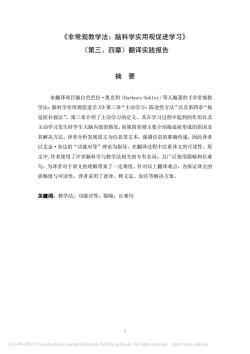
《非常规教学法:脑科学实用观促进学习》 (第三、四章)翻译实践报告 摘要 本翻译项目摘自芭芭拉·奥克利(Barbara Oakley)等人编著的《非常规教 学法:脑科学实用观促进学习》第三章“主动学习:陈述性方法”以及第四章“拖 延症补救法”。第三章介绍了主动学习的定义、其在学习过程中起到的作用以及 主动学习发生时学生大脑内部的情况,而第四章则主要介绍拖延症形成的原因及 其解决方法。译者分析发现原文为信息型文本,强调信息的准确传递,因此译者 以尤金·奈达的“功能对等”理论为指导,在翻译过程中注重译文的可读性。原 文中,作者使用了许多脑科学与教学法相关的专有名词,且广泛使用隐喻和长难 句,为译者对于原文的理解带来了一定难度。针对以上翻译难点,为保证译文的 流畅度与可读性,译者采用了意译、释义法、加注等解决方案。 关键词:教学法:功能对等:隐喻:长难句 (C)1994-2022 China Academie Joumal Electronie Publishing House.All rights reserved.http://www.enki.net
i 《非常规教学法:脑科学实用观促进学习》 (第三、四章)翻译实践报告 摘 要 本翻译项目摘自芭芭拉·奥克利(Barbara Oakley)等人编著的《非常规教 学法:脑科学实用观促进学习》第三章“主动学习:陈述性方法”以及第四章“拖 延症补救法”。第三章介绍了主动学习的定义、其在学习过程中起到的作用以及 主动学习发生时学生大脑内部的情况,而第四章则主要介绍拖延症形成的原因及 其解决方法。译者分析发现原文为信息型文本,强调信息的准确传递,因此译者 以尤金·奈达的“功能对等”理论为指导,在翻译过程中注重译文的可读性。原 文中,作者使用了许多脑科学与教学法相关的专有名词,且广泛使用隐喻和长难 句,为译者对于原文的理解带来了一定难度。针对以上翻译难点,为保证译文的 流畅度与可读性,译者采用了意译、释义法、加注等解决方案。 关键词:教学法;功能对等;隐喻;长难句

A Report on the Translation of Uncommon Sense Teaching:Practical Insights in Brain Science to Help Students Learn (Chapters 3 4) Abstract The source text of this translation project is the third and the fourth chapters from the book Uncommon Sense Teaching:Practical Insights in Brain Science to Help Students Learn written by Barbara Oakley.Beth Rogowsky,Terrence J Sejnowski including "Active Learning:The Declarative Pathway"and "Remedies for Procrastination"among which the first one introduces the definition of active learning. its usage in the study,as well as what's going on in the brain during the process,while the next chapter mainly talks about procrastination,the reason why procrastination happens and the solution to combat it.As the source text is an informative text which focuses on the transmission of information,the translator rendered a readable text by adopting the principle of"functional equivalence".In the source text,the use of proper nouns,metaphors and complex clauses has caused difficulty in understanding the source text.In order to solve these difficulties above and make a readable translation, the translator adopts some methods such as liberal translation,paraphrasing,and annotation Key words:teaching method;functional equivalence;metaphor;complex clause (C)1994-022 China Academie Jourmal Electronie Publishing House.All rights reserved.http://www.enki.net
i A Report on the Translation of Uncommon Sense Teaching: Practical Insights in Brain Science to Help Students Learn (Chapters 3 & 4) Abstract The source text of this translation project is the third and the fourth chapters from the book Uncommon Sense Teaching: Practical Insights in Brain Science to Help Students Learn written by Barbara Oakley, Beth Rogowsky, Terrence J Sejnowski, including “Active Learning: The Declarative Pathway” and “Remedies for Procrastination”, among which the first one introduces the definition of active learning, its usage in the study, as well as what’s going on in the brain during the process; while the next chapter mainly talks about procrastination, the reason why procrastination happens and the solution to combat it. As the source text is an informative text which focuses on the transmission of information, the translator rendered a readable text by adopting the principle of “functional equivalence”. In the source text, the use of proper nouns, metaphors and complex clauses has caused difficulty in understanding the source text. In order to solve these difficulties above and make a readable translation, the translator adopts some methods such as liberal translation, paraphrasing, and annotation. Key words: teaching method; functional equivalence; metaphor; complex clause
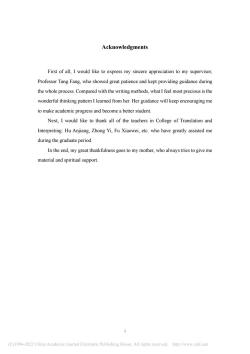
Acknowledgments First of all,I would like to express my sincere appreciation to my supervisor, Professor Tang Fang,who showed great patience and kept providing guidance during the whole process.Compared with the writing methods,what I feel most precious is the wonderful thinking pattern I learned from her.Her guidance will keep encouraging me to make academic progress and become a better student. Next,I would like to thank all of the teachers in College of Translation and Interpreting:Hu Anjiang.Zhong Yi,Fu Xiaowei,etc.who have greatly assisted me during the graduate period. In the end,my great thankfulness goes to my mother,who always tries to give me material and spiritual support. C)1994-2022 China Academie Joumal Electronie Publishing House.All rights reserved.http://www.enki.net
i Acknowledgments First of all, I would like to express my sincere appreciation to my supervisor, Professor Tang Fang, who showed great patience and kept providing guidance during the whole process. Compared with the writing methods, what I feel most precious is the wonderful thinking pattern I learned from her. Her guidance will keep encouraging me to make academic progress and become a better student. Next, I would like to thank all of the teachers in College of Translation and Interpreting: Hu Anjiang, Zhong Yi, Fu Xiaowei, etc. who have greatly assisted me during the graduate period. In the end, my great thankfulness goes to my mother, who always tries to give me material and spiritual support
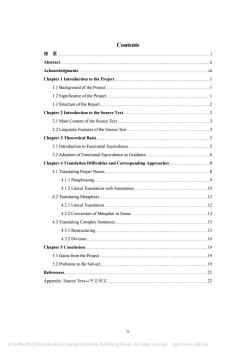
Contents 摘要」 Abstract Chapter 1 Introduction to the Project. 1.1 Background of the Project. .1 1.2 Significance of the Project. 1.3 Structure of the Report. .2 Chapter 2 Introduction to the Source Text 2.1 Main Content of the Source Text. 2.2 Linguistic Features of the Source Text. 3 Chapter 3Theoretical Basis. 5 3.1 Introduction to Functional Equivalence. 32 Adoption of Functional Equivalence as Guidance6 Chapter 4Translation Difficulties and Corresponding Approaches. 8 4.1 Translating Proper Nouns 8 4.1.1 Paraphrasing 4.1.2 Literal Translation with Annotation. .10 42 Translating Metaphors 4.2.1 Literal Translation 12 4.2.2 Conversion of Metaphor to Sense. 13 4.3 Translating Complex Sentences. 4.3.1 Restructuring. 15 Chapter 5 Conclusion. 19 5.1 Gains from the Project 19 5.2 Problems to Be Solved. .19 References. n21 Appendix:Source Text-中文译文 22 (C)1994-202 China Academie Joumal Electronie Publishing House.All rights reserved.http://www.enki.net
iv Contents 摘 要 . i Abstract . ii Acknowledgments . iii Chapter 1 Introduction to the Project . 1 1.1 Background of the Project . 1 1.2 Significance of the Project . 1 1.3 Structure of the Report . 2 Chapter 2 Introduction to the Source Text . 3 2.1 Main Content of the Source Text . 3 2.2 Linguistic Features of the Source Text . 3 Chapter 3 Theoretical Basis . 5 3.1 Introduction to Functional Equivalence . 5 3.2 Adoption of Functional Equivalence as Guidance . 6 Chapter 4 Translation Difficulties and Corresponding Approaches . 8 4.1 Translating Proper Nouns . 8 4.1.1 Paraphrasing . 9 4.1.2 Literal Translation with Annotation . 10 4.2 Translating Metaphors . 12 4.2.1 Literal Translation . 12 4.2.2 Conversion of Metaphor to Sense . 13 4.3 Translating Complex Sentences . 15 4.3.1 Restructuring . 15 4.3.2 Division . 16 Chapter 5 Conclusion . 19 5.1 Gains from the Project . 19 5.2 Problems to Be Solved . 19 References . 21 Appendix: Source Text—中文译文 . 22
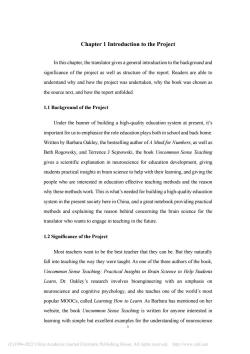
Chapter 1 Introduction to the Project In this chapter,the translator gives a general introduction to the background and significance of the project as well as structure of the report.Readers are able to understand why and how the project was undertaken,why the book was chosen as the source text,and how the report unfolded 1.1 Background of the Project Under the banner of building a high-quality education system at present,it's important for us to emphasize the role education plays both in school and back home Written by Barbara Oakley,the bestselling author of A Mind for Numbers,as well as Beth Rogowsky,and Terrence J Sejnowski,the book Uncommon Sense Teaching gives a scientific explanation in neuroscience for education development,giving students practical insights in brain science to help with their learning.and giving the people who are interested in education effective teaching methods and the reason why these methods work.This is what's needed for building a high-quality education system in the present society here in China,and a great notebook providing practical methods and explaining the reason behind concerning the brain science for the translator who wants to engage in teaching in the future 1.2 Significance of the Project Most teachers want to be the best teacher that they can be.But they naturally fall into teaching the way they were taught.As one of the three authors of the book, Uncommon Sense Teaching:Practical Insights in Brain Science to Help Students Learn,Dr.Oakley's research involves bioengineering with an emphasis on neuroscience and cognitive psychology,and she teaches one of the world's most popular MOOCs,called Learning Howto Learn.As Barbara has mentioned on her website,the book Uncommon Sense Teaching is written for anyone interested in learning with simple but excellent examples for the understanding of neuroscience (C)1994-2022 China Academie Joural Electronie Publishing House.All rights reserved.http://www.enki.net
1 Chapter 1 Introduction to the Project In this chapter, the translator gives a general introduction to the background and significance of the project as well as structure of the report. Readers are able to understand why and how the project was undertaken, why the book was chosen as the source text, and how the report unfolded. 1.1 Background of the Project Under the banner of building a high-quality education system at present, it’s important for us to emphasize the role education plays both in school and back home. Written by Barbara Oakley, the bestselling author of A Mind for Numbers, as well as Beth Rogowsky, and Terrence J Sejnowski, the book Uncommon Sense Teaching gives a scientific explanation in neuroscience for education development, giving students practical insights in brain science to help with their learning, and giving the people who are interested in education effective teaching methods and the reason why these methods work. This is what’s needed for building a high-quality education system in the present society here in China, and a great notebook providing practical methods and explaining the reason behind concerning the brain science for the translator who wants to engage in teaching in the future. 1.2 Significance of the Project Most teachers want to be the best teacher that they can be. But they naturally fall into teaching the way they were taught. As one of the three authors of the book, Uncommon Sense Teaching: Practical Insights in Brain Science to Help Students Learn, Dr. Oakley’s research involves bioengineering with an emphasis on neuroscience and cognitive psychology, and she teaches one of the world’s most popular MOOCs, called Learning How to Learn. As Barbara has mentioned on her website, the book Uncommon Sense Teaching is written for anyone interested in learning with simple but excellent examples for the understanding of neuroscience
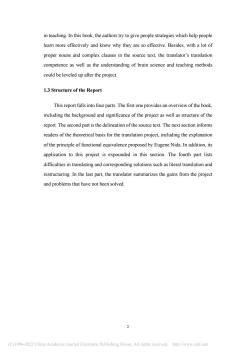
in teaching.In this book,the authors try to give people strategies which help people learn more effectively and know why they are so effective.Besides,with a lot of proper nouns and complex clauses in the source text,the translator's translation competence as well as the understanding of brain science and teaching methods could be leveled up after the project. 1.3 Structure of the Report This report falls into four parts.The first one provides an overview of the book, including the background and significance of the project as well as structure of the report.The second part is the delineation of the source text.The next section informs readers of the theoretical basis for the translation project,including the explanation of the principle of functional equivalence proposed by Eugene Nida.In addition,its application to this project is expounded in this section.The fourth part lists difficulties in translating and corresponding solutions such as literal translation and restructuring.In the last part,the translator summarizes the gains from the project and problems that have not been solved. 2 (C)1994-022 China Academie Jourmal Electronie Publishing House.All rights reserved.http://www.enki.net
2 in teaching. In this book, the authors try to give people strategies which help people learn more effectively and know why they are so effective. Besides, with a lot of proper nouns and complex clauses in the source text, the translator’s translation competence as well as the understanding of brain science and teaching methods could be leveled up after the project. 1.3 Structure of the Report This report falls into four parts. The first one provides an overview of the book, including the background and significance of the project as well as structure of the report. The second part is the delineation of the source text. The next section informs readers of the theoretical basis for the translation project, including the explanation of the principle of functional equivalence proposed by Eugene Nida. In addition, its application to this project is expounded in this section. The fourth part lists difficulties in translating and corresponding solutions such as literal translation and restructuring. In the last part, the translator summarizes the gains from the project and problems that have not been solved
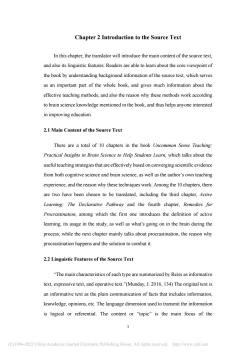
Chapter 2 Introduction to the Source Text In this chapter,the translator will introduce the main content of the source text. and also its linguistic features.Readers are able to learn about the core viewpoint of the book by understanding background information of the source text,which serves as an important part of the whole book,and gives much information about the effective teaching methods.and also the reason why these methods work according to brain science knowledge mentioned in the book,and thus helps anyone interested in improving education. 2.1 Main Content of the source Text There are a total of 10 chapters in the book Uncommon Sense Teaching Practical Insights in Brain Science to Help Students Learn,which talks about the useful teaching strategies that are effectively based on converging scientific evidence from both cognitive science and brain science,as well as the author's own teaching experience,and the reason why these techniques work.Among the 10 chapters,there are two have been chosen to be translated,including the third chapter,Active Learning:The Declarative Pathway and the fourth chapter,Remedies for Procrastination,among which the first one introduces the definition of active learning,its usage in the study,as well as what's going on in the brain during the process;while the next chapter mainly talks about procrastination,the reason why procrastination happens and the solution to combat it. 2.2 Linguistic Features of the Source Text "The main characteristics of each type are summarized by Reiss as informative text,expressive text,and operative text."(Munday,J.2016,134)The original text is an informative text as the plain communication of facts that includes information, knowledge,opinions,etc.The language dimension used to transmit the information is logical or referential.The content or "topic"is the main focus of the (C)1994-022 China Academie Joumal Eleetronie Publishing House.All rights reserved.http://www.enki.net
3 Chapter 2 Introduction to the Source Text In this chapter, the translator will introduce the main content of the source text, and also its linguistic features. Readers are able to learn about the core viewpoint of the book by understanding background information of the source text, which serves as an important part of the whole book, and gives much information about the effective teaching methods, and also the reason why these methods work according to brain science knowledge mentioned in the book, and thus helps anyone interested in improving education. 2.1 Main Content of the Source Text There are a total of 10 chapters in the book Uncommon Sense Teaching: Practical Insights in Brain Science to Help Students Learn, which talks about the useful teaching strategies that are effectively based on converging scientific evidence from both cognitive science and brain science, as well as the author’s own teaching experience, and the reason why these techniques work. Among the 10 chapters, there are two have been chosen to be translated, including the third chapter, Active Learning: The Declarative Pathway and the fourth chapter, Remedies for Procrastination, among which the first one introduces the definition of active learning, its usage in the study, as well as what’s going on in the brain during the process; while the next chapter mainly talks about procrastination, the reason why procrastination happens and the solution to combat it. 2.2 Linguistic Features of the Source Text “The main characteristics of each type are summarized by Reiss as informative text, expressive text, and operative text.”(Munday, J. 2016, 134) The original text is an informative text as the plain communication of facts that includes information, knowledge, opinions, etc. The language dimension used to transmit the information is logical or referential. The content or “topic” is the main focus of the
按次数下载不扣除下载券;
注册用户24小时内重复下载只扣除一次;
顺序:VIP每日次数-->可用次数-->下载券;
- 《运动解剖学》课程文献资料(脑科学)《非常规教学法:脑科学实用观促进学习》(第一、二章)翻译实践报告.pdf
- 《运动解剖学》课程教学资源(文献资料)心脏与骨骼肌Smyd1及其运动干预研究进展.pdf
- 山东理工大学:《运动解剖学》课程教学资源(授课教案,共二十八课次).pdf
- 《运动解剖学》课程文献资料(脑科学)运动促进大脑健康:来自行为和脑科学的证据_金鑫虹.pdf
- 《运动解剖学》课程文献资料(脑科学)迁移学习及其在固体地球科学中的应用.pdf
- 《运动解剖学》课程文献资料(脑科学)跨学科开启头脑风暴促进脑科学交叉与融合.pdf
- 《运动解剖学》课程文献资料(脑科学)认知神经科学视域下中学小说整本书阅读教学方法研究.pdf
- 《运动解剖学》课程文献资料(脑科学)英国教育神经科学:缘起、发展与反思.pdf
- 《运动解剖学》课程文献资料(脑科学)自我决定理论视角下小学科学游戏化学习中学生学习投入研究.pdf
- 《运动解剖学》课程文献资料(脑科学)美国以学生为中心”的大学教学设计模式和教学方法研究.pdf
- 《运动解剖学》课程文献资料(脑科学)探索脑’的奥秘”高中生物学校本课程开发与实践研究.pdf
- 《运动解剖学》课程文献资料(脑科学)指向科学思维”素养发展的学习活动设计.pdf
- 《运动解剖学》课程文献资料(脑科学)指向深度学习的高中化学科学论证教学实践研究.pdf
- 《运动解剖学》课程文献资料(脑科学)战略规划视角下脑科学领域未来发展趋势研究.pdf
- 《运动解剖学》课程文献资料(脑科学)应用学习科学指导环境设计混合式教学的探究_贺珊.pdf
- 《运动解剖学》课程文献资料(脑科学)巧设探究作业,让科学学习更有效以《小小机械师》单元探究作业设计实施为例.pdf
- 《运动解剖学》课程文献资料(脑科学)学习进阶视域下培养科学思维的教学研究以圆周运动”为例.pdf
- 《运动解剖学》课程文献资料(脑科学)学习科学视域下的项目学习研究.pdf
- 《运动解剖学》课程文献资料(脑科学)学习科学视域下的深度教学研究_刘含英.pdf
- 《运动解剖学》课程文献资料(脑科学)学习科学视域下学生深度学习的激发与促进_袁萌.pdf
- 《运动解剖学》课程文献资料(脑科学)从STEM到STEAM脑科学基础及教育启示.pdf
- 《运动解剖学》课程文献资料(脑科学)从脑科学诠释体育运动提升学习效益的理论与实践_周成林.pdf
- 《运动解剖学》课程文献资料(脑科学)共同富裕视域下分配公平对幸福感的影响因果推断与机器学习在社会科学中的融合应用.pdf
- 《运动解剖学》课程文献资料(脑科学)创新思维的脑生理、心理协同发生机制探析.pdf
- 《运动解剖学》课程文献资料(脑科学)后疫情时代人类学习的未来趋向系统科学的哲学思考.pdf
- 《运动解剖学》课程文献资料(脑科学)基于学习科学的“以学为中心”教学研究与实践_刘庆华.pdf
- 《运动解剖学》课程文献资料(脑科学)基于学本评估”理论的混合学习评价活动设计研究.pdf
- 《运动解剖学》课程文献资料(脑科学)基于混合学习的生物科学专业学生学习风格研究以唐山师范学院为例.pdf
- 《运动解剖学》课程文献资料(脑科学)基于混合式教学的中医内科学学习策略探究_于鹏龙.pdf
- 《运动解剖学》课程文献资料(脑科学)基于神经科学的道德认知研究_艾鹏.pdf
- 《运动解剖学》课程文献资料(脑科学)基于科创竞赛的科学教育:学习环境、学习过程与培养效果.pdf
- 《运动解剖学》课程文献资料(脑科学)基于科学探究能力发展的项目式学习在中学生物学教学中的实践研究.pdf
- 《运动解剖学》课程文献资料(脑科学)基于突触可塑性的复杂系统中信息传输机制的研究.pdf
- 《运动解剖学》课程文献资料(脑科学)基于翻转课堂的小学科学项目式学习活动设计研究.pdf
- 《运动解剖学》课程文献资料(脑科学)基于脑科学的微课教学设计探索.pdf
- 《运动解剖学》课程文献资料(脑科学)基于项目化学习培养科学思维能力的实践研究以高中生物学探究实验为例.pdf
- 《运动解剖学》课程文献资料(脑科学)基于项目式学习的科学教育领域跨学科概念建构.pdf
- 《运动解剖学》课程文献资料(脑科学)建筑的神经科学研究——缘起、内容与工具_周祥.pdf
- 《运动解剖学》课程文献资料(脑科学)教育文化视域下学习科学的研究趋势_李凤营.pdf
- 《运动解剖学》课程文献资料(脑科学)教育神经科学视域下的高中物理教学设计研究以静电场及其应用”为例.pdf
